Airbus Announces Large Production Cuts Due to COVID-19 Fallout as Boeing Temporarily Suspends Operations in Washington and South Carolina.
by J. Kasper Oestergaard, European Correspondent, Forecast International.
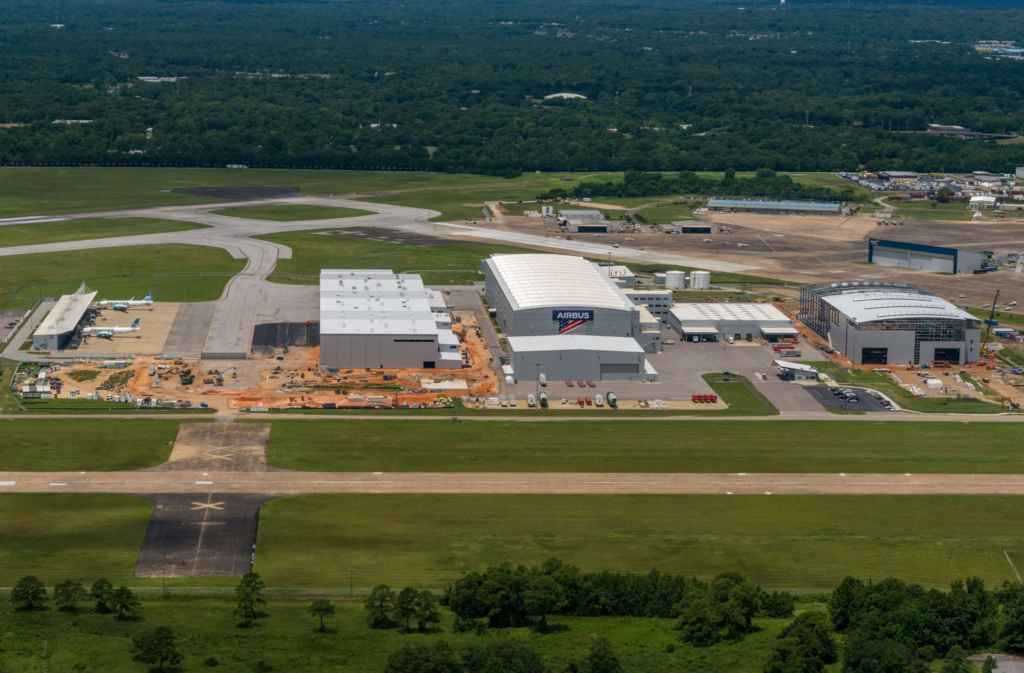
Boeing and Airbus delivered 20 and 36 commercial jets in March 2020, compared to 54 and 74 deliveries, respectively, in the same month last year. With just 50 deliveries this year to date, Boeing is 99 shipments behind last year’s total for the first quarter. Airbus delivered a total of 122 jets from January to March, compared to 162 during the same period last year. Boeing’s deliveries have suffered for many months in the aftermath of two 737 MAX crashes and the subsequent suspension of deliveries and grounding of the fleet. Deliveries of 737 MAX aircraft have been put on hold since March 2019. Due to COVID-19, both manufacturers have been forced to temporarily close down production facilities. For the full year 2019, Boeing delivered 380 aircraft, while Airbus set a new all-time annual record, handing over 863 jets. Prior to this, Boeing had retained a deliveries lead over Airbus since 2012. In 2018, Boeing delivered 806 jets (763 in 2017), with Airbus handing over 800 (718 in 2017).
In March, Boeing delivered one 737NG, five 767s, three 777s and 11 787s. Boeing’s shipments will likely take a substantial hit in April due to the ongoing suspension of production at the company’s locations in Washington and South Carolina. On March 23, Boeing announced that all production at its facilities in Washington would be shut down for 14 days commencing March 25. On April 5, Boeing announced that the suspension had been extended until further notice. In addition, on April 6, Boeing announced it will temporarily suspend all 787 operations in South Carolina until further notice, starting April 8. On April 13, Boeing reopened some of its production operations, including the build line for the 767-based KC-46 tanker at its Everett facility. Work has also resumed on the P-8A Poseidon in Renton and the 737 MAX at Moses Lake. On April 16, Boeing announced it will restart commercial airplane production in a phased approach at its Washington facilities starting Monday, April 20. Employees on the 737, 747, 767 and 777 programs will return on April 20, with most returning to work by April 21. Employees on the 787 program will return on April 23, with most returning to work by April 24.
Production of the 737 MAX has been suspended since January. Prior to this, Boeing had been producing 737 MAX jets at a reduced rate of 42 aircraft per month. Boeing expects the aircraft to resume service in mid-2020, and the latest plans are calling for a restart of 737 MAX production by May. However, in these uncertain times, plans are frequently postponed, and the 737 MAX’s return to the fleet has been delayed several times in the past. In the meantime, test flights and software changes continue. In any case, it will be a few years before Boeing is able to hit the planned monthly production rate of 57 aircraft. Prior to the suspension of deliveries in March 2019, Boeing had delivered 387 737 MAX jets.
In March, Airbus delivered two A220s, 30 A320s (1 CEO / 29 NEO), one A330, and three A350s. Prior to COVID-19, Airbus was targeting a 5 percent rate increase to 63 jets per month from 2021 and was also discussing a further ramp-up with its supply chain that could have brought the production rate up to as high as 67 aircraft per month, or 804 per year, by 2023, putting the company within reach of a total of 1,000 jet deliveries per year. Those plans have now been shelved. For the full year 2019, Airbus handed over 642 A320 family aircraft, of which 551 were A320neos. This compares to a total of 386 A320neo family aircraft deliveries in 2018, up from 181 and 68 in 2017 and 2016, respectively. Airbus delivered a record 112 A350s in 2019, up from 93 and 78 in 2018 and 2017, respectively. Airbus increased the monthly A350 production rate to 10 during 2019.
Due to the COVID-19 pandemic, Airbus will cut production on several programs for the remainder of the year. The A320 production rate has been reduced to 40 aircraft per month, down from an average of over 53 aircraft per month in 2019. The A330 and A350 programs are reduced to a rate of two and six aircraft per month, respectively. No rate cut has been announced for the A220 or A380, but Airbus has delayed a planned A220 production ramp-up at its Mirabel facility near Montreal, where the company has been producing four A220s per month. Production at the facility is currently suspended until early May. Airbus has also suspended production at its U.S. facility in Mobile, Alabama, where it produces A220 and A320 narrowbody jets. Commercial production and assembly activities in Bremen, Germany, are paused until April 27. Airbus in Stade near Hamburg was closed down from April 5-11 but has since reopened. Production and assembly work in France has resumed gradually since March 23, although commercial aircraft wing production in the U.K. and commercial production activities in Spain have been temporarily suspended. Airbus has also received multiple requests from customers to defer deliveries, and the company is seeking solutions case by case and aircraft by aircraft.
Turning to the orders race, Boeing reported 31 gross orders in March and 150 cancellations, for a total of -119 net new orders. Orders included 11 787-10s and one 787-9 for Japan’s All Nippon Airways (ANA), the 787 launch customer. Also, FedEx ordered a single 767 freighter. Also, on March 30, Boeing was awarded a $1.5 billion contract by the U.S. Navy for the next 18 P-8A Poseidon maritime warfare aircraft. The P-8A is a heavily modified 737-800. The contract includes eight aircraft for the U.S. Navy, six aircraft for the Republic of Korea Navy, and four aircraft for the Royal New Zealand Air Force. Year-to-date, Boeing has accumulated 49 gross orders (196 cancellations => -147 net new orders). For the full year 2019, Boeing accumulated 243 gross orders (330 cancellations => -87 net new orders). For the full year 2018, Boeing booked 893 net new orders and 1,008 gross orders.
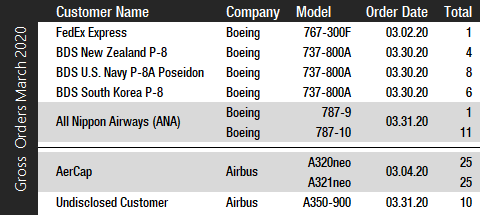
In March, Airbus booked 60 gross orders and reported 44 cancellations, for a net of 16. Irish leasing firm AerCap placed orders for 25 A320neos and 25 A321neos, while an undisclosed customer ordered 10 A350-900s. For 2020 to date, Airbus has accumulated 356 gross orders (66 cancellations => net of 290). For the full year 2019, Airbus landed 1,131 gross orders (363 cancellations => net of 768), thereby retaking the orders crown from Boeing. In 2018, Airbus booked a total of 747 net new orders and 831 gross orders, thereby losing the 2018 orders race. Prior to this, Airbus had retained an orders lead over its rival every year since 2012.
At the end of March, Airbus reported a backlog of 7,650 jets, of which 6,749, or 88 percent, were A220 and A320ceo/neo family narrowbodies. This is 75 aircraft below the company’s all-time backlog record of 7,725 aircraft set in January 2020. By the end of March 2020, Boeing’s backlog (total unfilled orders before ASC 606 adjustment) was 5,428 aircraft, of which 4,407, or 81 percent, were 737 NG/MAX narrowbody jets. Boeing’s all-time backlog high of 5,964 aircraft was set in August 2018. The number of Airbus aircraft to be built and delivered represents 8.9 years of shipments at the 2019 production level. In comparison, Boeing’s backlog would “only” last 6.7 years at the 2018 level, which we use as a proxy for 2019 due to the drop in 737 MAX deliveries. This year to date, Boeing’s book-to-bill ratio, calculated as net new orders divided by deliveries, is negative due to cancellations exceeding gross orders. Airbus’ book-to-bill ratio is 2.38, mainly thanks to very strong order bookings in January. In 2019, Boeing’s book-to-bill ratio was negative, while Airbus reported a book-to-bill of 0.89.
2020 Forecast
Forecast International’s Platinum Forecast System® is a breakthrough in forecasting technology which, among many other features, provides 15-year production forecasts. The author has used the Platinum Forecast System to retrieve the latest delivery forecasts and, for 2020, Forecast International’s analysts expect Boeing and Airbus to deliver 421 and 564 commercial jets, respectively.
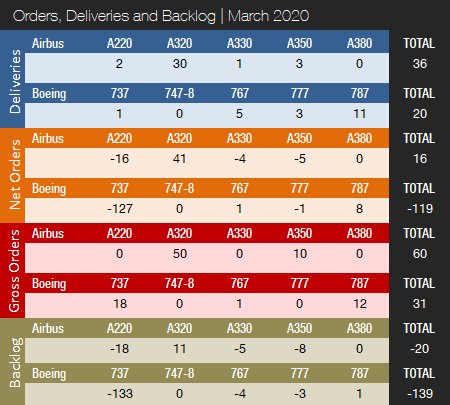
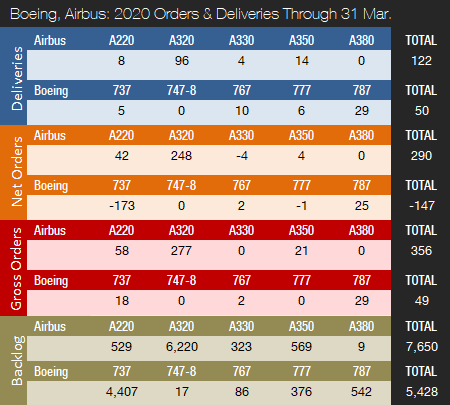
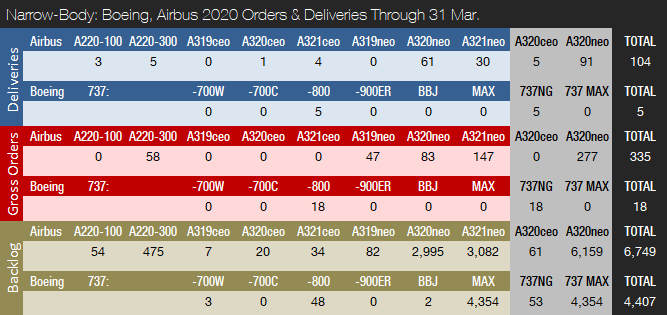
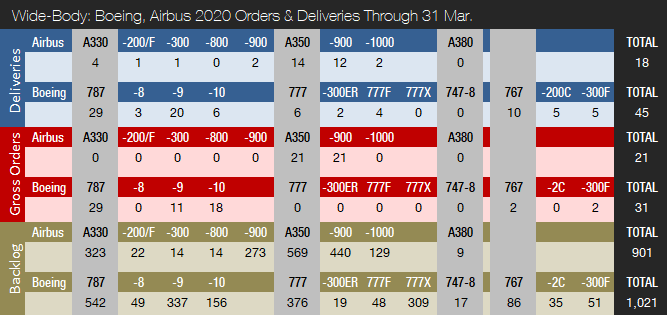
Note: Boeing 777-300ER orders include one 777-200LR. The 777-300ER backlog includes two 777-200LRs.


Based in Denmark, Joakim Kasper Oestergaard is Forecast International’s AeroWeb and PowerWeb Webmaster and European Editor. In 2008, he came up with the idea for what would eventually evolve into AeroWeb. Mr. Oestergaard is an expert in aerospace & defense market intelligence, fuel efficiency in civil aviation, defense spending and defense programs. He has an affiliation with Terma Aerostructures A/S in Denmark – a leading manufacturer of composite and metal aerostructures for the F-35 Lightning II. Mr. Oestergaard has a Master’s Degree in Finance and International Business from the Aarhus School of Business – Aarhus University in Denmark.
References:
- http://www.boeing.com/commercial/#/orders-deliveries
- https://www.airbus.com/aircraft/market/orders-deliveries.html
- https://www.boeing.com/commercial/737max/737-max-update.page
- https://boeing.mediaroom.com/2020-03-30-Boeing-Receives-1-5-Billion-P-8A-Poseidon-Contract-From-U-S-Navy
- https://boeing.mediaroom.com/news-releases-statements?item=130657
- https://boeing.mediaroom.com/news-releases-statements?item=130656
- https://boeing.mediaroom.com/2020-03-23-Boeing-to-Temporarily-Suspend-Puget-Sound-Production-Operations-in-Response-to-Escalating-COVID-19-Pandemic
- https://www.airforcemag.com/boeing-to-reopen-kc-46-production-line/
- https://boeing.mediaroom.com/2020-04-14-Boeing-to-Release-First-Quarter-Results-on-April-29
- https://www.newsmax.com/us/boeing-737-max-production-pandemic/2020/03/24/id/959815/
- https://www.reuters.com/article/us-boeing-737max/boeing-unlikely-to-hit-pre-grounding-output-targets-for-737-max-before-2022-idUSKBN206291?il=0
- https://www.reuters.com/article/us-airbus-nl-production-a220/airbus-puts-off-planned-ramp-up-of-a220-jet-idUSKCN21X3DO
- https://www.airbus.com/newsroom/press-releases/en/2020/04/airbus-adapts-commercial-aircraft-production-and-assembly-activities-in-northern-germany-and-alabama-sites-in-covid19-environment.html
- https://dsm.forecastinternational.com/wordpress/2020/04/09/airbus-to-cut-production-rates-as-demand-from-airline-plummets/
- https://dsm.forecastinternational.com/wordpress/2020/04/06/covid-19-european-status-airbus-contemplating-large-a320-production-cut/
- https://www.reuters.com/article/us-airbus-shareholders/airbus-evaluates-requests-for-delays-to-jet-deliveries-idUSKCN21Y1SQ
A military history enthusiast, Richard began at Forecast International as editor of the World Weapons Weekly newsletter. As the Internet grew in importance as a research tool, he helped design the company's Forecast Intelligence Center and currently coordinates the EMarket Alert newsletters for clients. Richard also manages social media efforts, including two new blogs: Defense & Security Monitor, covering defense systems and international issues, and Flight Plan, which focuses on commercial aviation and space systems. For over 30 years, Richard has authored the Defense & Aerospace Companies, Volume I (North America) and Volume II (International) services. The two books provide detailed data on major aerospace and defense contractors. He also edits the International Contractors service, a database that tracks all the contractors involved in the programs covered in the FI library. More recently he was appointed Manager, Information Services Group (ISG), a new unit that encompasses developing outbound content for both Forecast International and Military Periscope.




